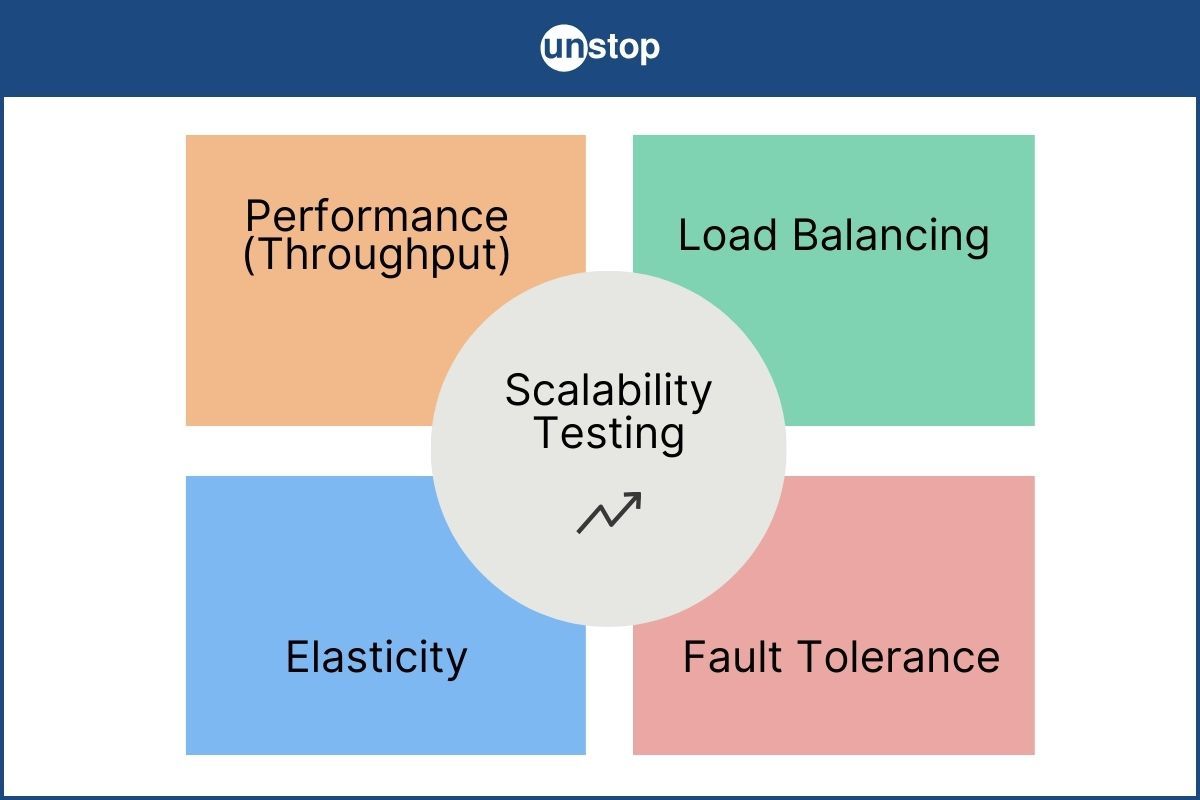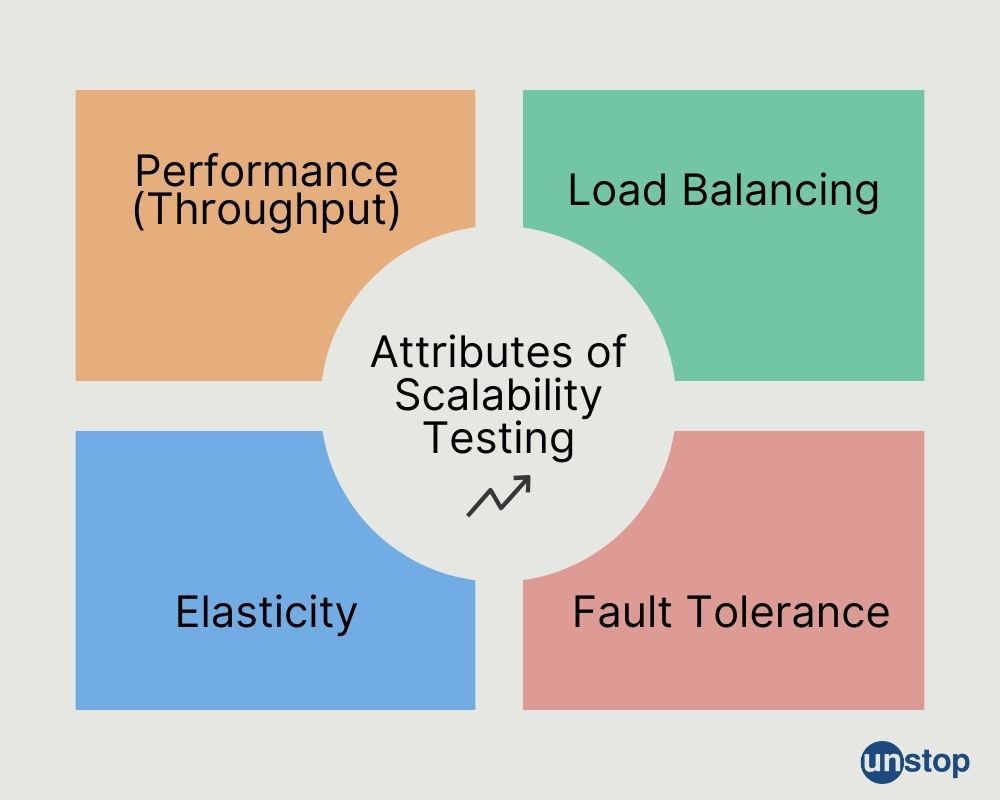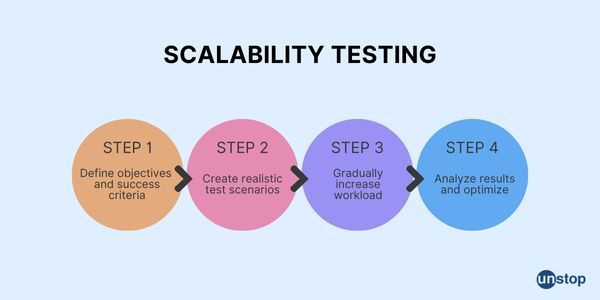- Scalability Testing: Impact, Pros & Cons
- Types and Attributes of Scalability Testing
- Difference Between Scalability Testing and Load Testing
- Prerequisites for Effective Scalability Testing
- Steps to Conduct Scalability Testing
- Analyzing Results: Proportional vs Unproportional Outcomes
- Enhancing User Experience through Scalability Testing
- Frequently Asked Questions (FAQs)
Scalability Testing Explained: Understand Its Steps, Benefits & Impact

Scalability testing is a crucial aspect of software development. It helps evaluate the performance of a system under increasing workload, ensuring that applications can handle growth and increased user demand. By conducting a scalability test, developers can identify potential bottlenecks and optimize their systems to scale effectively.
This type of testing focuses on load testing and capacity testing, examining how well an application performs as the data volume or user base increases. Starting at a particular scale, scalability tests assess how the system handles the growing workload without compromising its functionality or response time.
Scalability Testing: Impact, Pros & Cons
Scalability testing plays a vital role in preparing businesses for future growth. One of the key impacts of effective scalability testing is improved customer satisfaction. When a system is properly tested for scalability, it can handle higher volumes of users without experiencing slowdowns or crashes. This means that customers can access the system quickly and smoothly, leading to a positive user experience.
Another significant impact of scalability testing is preventing revenue loss due to system failures. Imagine if an e-commerce website experiences a surge in traffic during a major sale event but fails to handle the increased load. Customers may face difficulties placing orders or even encounter website crashes, resulting in lost sales opportunities. By conducting scalability testing beforehand, businesses can ensure their systems are robust enough to handle peak loads, minimizing revenue loss.
In addition to these benefits, scalability testing also helps businesses optimize resource allocation by identifying areas where additional resources are needed. It provides insights into how much capacity the system has and allows organizations to make informed decisions about scaling up their infrastructure when necessary.
Pros of scalability testing:
-
Helps ensure that the system can accommodate future growth without performance degradation.
-
Identifies potential issues related to resource allocation and utilization.
-
Allows for proactive optimization, ensuring smooth operation as workload increases.
Cons of Scalability Testing:
-
Requires careful planning and execution to accurately simulate real-world scenarios.
-
Can be time-consuming and resource-intensive, especially with complex systems.
-
Results may vary depending on various factors such as hardware configurations or network conditions.
Types and Attributes of Scalability Testing

When it comes to the attributes of scalability testing, there are several key factors to consider.
-
Performance (Throughput): Scalability testing assesses how well a system performs under increasing workloads. It measures response times, throughput, and resource utilization to determine if the system can handle the anticipated growth without compromising performance.
-
Load Balancing: Scalability testing examines how a system distributes the workload across multiple resources. It tests the effectiveness of load-balancing algorithms and ensures that the system can efficiently allocate resources to handle increased demands.
-
Elasticity: This attribute focuses on the system's ability to dynamically scale up or down based on the workload. Scalability testing assesses how well a system can adapt to changing demands by adding or removing resources as needed, ensuring optimal performance and cost-efficiency.
-
Fault Tolerance: Scalability testing evaluates the system's resilience in the face of failures or disruptions. It measures how well the system can recover from failures, maintain data integrity, and continue to function without significant impact on performance.
Now, let's discuss the two main types of scalability testing:
-
Vertical Scalability Testing: Also known as scaling up, this type of testing involves increasing the capacity of a single resource, such as adding more memory or processing power to a server. It helps determine the maximum capacity of a single resource and assesses the system's ability to handle increased loads on a single machine.
-
Horizontal Scalability Testing: Also known as scaling out, this testing focuses on adding more resources, such as servers, to distribute the workload. It tests the system's ability to effectively utilize multiple resources and maintain performance as the workload increases.
Apart from these two, other common types of scalability testing are:
Stress Testing: Stress testing is a type of scalability testing that evaluates the system's ability to handle extreme or peak loads. It involves pushing the system to its limits by increasing the workload beyond normal capacity. The goal is to identify any weaknesses or bottlenecks in the system and determine how it performs under stressful conditions. This type of testing helps ensure that the system can handle unexpected spikes in traffic or usage without crashing or experiencing performance degradation.
Soak Testing: Soak testing, also known as endurance testing, is a type of scalability testing that assesses the system's ability to handle sustained or continuous loads over an extended period. It involves running the system under normal or heavy loads for an extended duration, typically 24 to 48 hours, to identify any performance degradation or resource leaks that may occur over time. The goal of soak testing is to ensure that the system can maintain stable performance and functionality over long periods without any issues.
Failover Testing: Failover testing is a type of scalability testing that evaluates the system's ability to handle failover scenarios. It involves simulating the failure of a component, such as a server or network connection, and assessing how the system responds and recovers from the failure. The goal of failover testing is to ensure that the system can seamlessly switch to backup or redundant components without any disruption to the users or loss of data. This type of testing helps ensure high availability and reliability of the system.
Load Testing: This is a type of scalability testing that evaluates the system's performance under expected or anticipated loads. It involves simulating real-world user loads and transactions to assess how the system handles the workload. The goal of load testing is to identify performance bottlenecks, such as slow response times or high resource utilization, and determine the system's capacity and scalability limits. This type of testing helps ensure that the system can handle the expected user loads without degrading performance or experiencing any issues.
Notably, scalability testing can also have different types depending on the systems being tested. For example, database scalability testing evaluates the scalability of a database system, network scalability testing evaluates the scalability of a network infrastructure, etc. Some common types here are Application Scalability Testing, Cloud Scalability Testing, and Virtualization Scalability Testing.
Difference Between Scalability Testing and Load Testing
Here are the key differences between scalability and load testing:
| Criteria | Scalability Testing | Load Testing |
|---|---|---|
| What does it do? | Evaluates the ability of a system to handle increasing workloads and growing user demands. | Evaluates the behavior of a system under normal and peak load conditions. |
| End Result | Helps identify the maximum capacity of the system and determine if it can scale effectively. | Helps identify bottlenecks, performance issues, and the system's response time under different load levels. |
| How does it test? | Involves gradually increasing the workload to observe the system's performance and scalability. | Involves simulating real-life scenarios to assess the system's performance and stability under various load conditions. |
Prerequisites for Effective Scalability Testing
To ensure successful scalability testing, there are several prerequisites that need to be considered:
Accurate Workload Modeling
One of the key prerequisites is accurate workload modeling. This allows the simulation of real-world scenarios, ensuring that the system under test can handle the expected load and scale accordingly. By accurately modeling the workload, testers can mimic user behavior, traffic patterns, and data volumes that reflect the actual usage of the system.
Availability of Sufficient Resources
Another important prerequisite is having sufficient resources in place. This includes both hardware and network infrastructure. Without adequate resources, it becomes difficult to accurately assess scalability. Testers need to ensure that they have enough capacity in terms of servers, storage, and networking equipment to handle the desired load levels.
Test Environment Requirements
Creating an appropriate test environment is essential for effective scalability testing. The environment should closely resemble the production environment where the system will eventually be deployed. This ensures that any issues or bottlenecks identified during testing are reflective of what might occur in a real-world scenario.
Starting Point for Testing
Determining a starting point for testing is also crucial. This involves understanding the current state of the system's performance and identifying its limitations before scaling up or out. By establishing a baseline performance level, testers can accurately measure improvements achieved through scalability enhancements.
Availability of Skilled Resources
Lastly, having access to skilled resources who understand scalability concepts and techniques is vital for successful testing. These individuals can design appropriate test cases, analyze results effectively, and provide valuable insights into optimizing system performance.
By considering these prerequisites, organizations can ensure more accurate results and identify potential issues early on in the development lifecycle of their systems.
Steps to Conduct Scalability Testing

Define Objectives and Success Criteria
Clearly define the objectives and success criteria for scalability testing. This involves determining what you want to achieve with the tests and how you will measure success. For example, your objective might be to determine if your application can handle a certain number of concurrent users without performance degradation. The success criteria could be that the application maintains a response time of less than two seconds under this load.
Create Realistic Test Scenarios
Develop realistic test scenarios that accurately mimic expected usage patterns. These scenarios should reflect the different activities or actions that users typically perform on your application. By creating realistic test scenarios, you can ensure that you are testing your application under conditions that closely resemble real-world usage. For instance, if your application is an e-commerce website, a test scenario could involve simulating multiple users adding items to their shopping carts simultaneously.
Gradually Increase Workload
Gradually increase the workload on your system while monitoring key performance metrics. Start with a small number of virtual users or requests and gradually increase them over time. This allows you to identify the breaking point or threshold at which your system starts experiencing performance issues. Monitor critical performance metrics such as response time, CPU utilization, memory consumption, and network traffic during each stage of the test.
Analyze Results and Optimize
Analyze the results obtained from scalability testing and identify any bottlenecks or areas for improvement in your system's performance. Use these findings to optimize your application's architecture, database queries, caching mechanisms, or any other components that may impact scalability. By addressing these issues, you can enhance your system's ability to handle increased user loads effectively.
Analyzing Results: Proportional vs Unproportional Outcomes
Analyzing the results of scalability testing is crucial to understanding how a system performs under different workloads. Two possible outcomes that can be observed are proportional and nonproportional outcomes.
Proportional Outcomes
Proportional outcomes indicate that the system scales linearly with increased workload. In other words, as the workload increases, the system's performance also increases in a predictable and consistent manner. This is often seen as an ideal outcome, as it suggests that the system can handle expected growth without any major issues.
Nonproportional Outcomes
On the other hand, nonproportional outcomes suggest bottlenecks or inefficiencies in certain components or configurations of the system. These outcomes may manifest as unexpected decreases in performance or limitations when handling higher workloads. Identifying these nonproportional outcomes is essential for determining areas that require optimization or further investigation.
Analyzing these results involves examining various measures such as response time, throughput, and resource utilization. By studying these factors, it becomes possible to pinpoint specific components or configurations that may be causing the nonproportional outcomes.
The Importance of Analysis
Analyzing the results of scalability testing allows teams to make informed decisions about optimizing their systems for better performance. It provides valuable insights into potential weaknesses and areas for improvement. For example, if a particular component consistently shows poor scalability, it may be necessary to optimize its code or consider alternative solutions.
By analyzing scalability testing results thoroughly, organizations can avoid potential failures when their systems encounter high workloads. It helps them identify critical points in their infrastructure where improvements should be made before scaling up operations.
Enhancing User Experience through Scalability Testing
Scalability testing plays a crucial role in enhancing user experience by identifying and resolving performance issues early on. This ensures that users have smooth experiences even during peak usage periods.
Optimizing response times
One key benefit of scalability testing is the ability to optimize response times. By subjecting software applications to high-load scenarios, businesses can identify bottlenecks and areas for improvement. This leads to faster response times, which in turn increases customer satisfaction and improves user retention.
Avoiding negative reviews and brand damage
Scalability testing helps businesses avoid negative reviews, brand damage, and potential revenue loss due to poor performance. By conducting thorough tests, companies can ensure that their applications can handle a high volume of user requests without crashing or slowing down. This prevents frustrated users from leaving negative feedback and tarnishing the brand's reputation.
Ensuring efficient resource utilization
Through scalability testing, businesses can assess the ability of their applications to handle increased workloads efficiently. By monitoring metrics such as CPU usage and throughput, organizations can identify any inefficiencies or limitations in their systems. This allows them to make necessary adjustments or implement horizontal scaling strategies to accommodate higher loads effectively.
In conclusion, with scalability testing in place, businesses can confidently scale their operations without compromising on performance or user satisfaction.
Frequently Asked Questions (FAQs)
1. What is the difference between scalability testing and load testing?
Scalability testing focuses on evaluating an application's ability to handle increasing workloads by adding resources as needed. Load testing, on the other hand, assesses how well an application performs under anticipated normal or peak loads. While both types of tests are essential for ensuring optimal performance, scalability testing specifically addresses an application's ability to scale with growing demands.
2. How often should scalability testing be performed?
The frequency of scalability testing depends on various factors such as the nature of the application, expected growth rate, and changes made to the system architecture. However, it is generally recommended to conduct scalability tests during major updates or changes in infrastructure and periodically as part of ongoing maintenance to ensure continued optimal performance.
3. Can scalability issues be fixed after deployment?
While it is possible to address some scalability issues post-deployment through optimizations and adjustments, it is more efficient and cost-effective to identify and resolve these issues during the development phase or before scaling up operations significantly. Proactive scalability testing helps prevent potential bottlenecks from impacting users' experience while minimizing downtime or performance degradation.
4. What are the prerequisites for effective scalability testing?
To conduct effective scalability testing, organizations should have a clear understanding of their application's architecture, anticipated user base, and expected growth trajectory. Access to appropriate testing tools and resources is crucial. Adequate planning and coordination with stakeholders ensure that scalability tests are conducted accurately and yield meaningful results.
5. How can scalability testing enhance user experience?
Scalability testing allows organizations to identify performance limitations before they impact end-users. By simulating increased workloads, businesses can proactively optimize their infrastructure to handle growing demands without compromising on response times or system stability. This ensures a smooth user experience even during peak periods of activity, leading to higher customer satisfaction and retention rates.
I’m a reader first and a writer second, constantly diving into the world of content. If I’m not writing or reading, I like watching movies and dreaming of a life by the beach.
Login to continue reading
And access exclusive content, personalized recommendations, and career-boosting opportunities.
Subscribe
to our newsletter
Blogs you need to hog!

This Is My First Hackathon, How Should I Prepare? (Tips & Hackathon Questions Inside)

10 Best C++ IDEs That Developers Mention The Most!

Advantages and Disadvantages of Cloud Computing That You Should Know!













Comments
Add comment